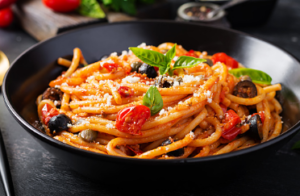Takeaway pasta: How to Cook Takeaway Pasta
Yes, you can get Pasta delivery from restaurants in Brooklyn. Find top-rated Taskers to make your delivery faster and safer.
Fresh pasta retains its hearty “bite” even during delivery and reheating. To help ensure that, chefs drain the pasta just short of al dente. Then, a final touch of oil or butter adds richness. For more Pasta Go Go takeaway pasta, check this out.
 Ingredients
Ingredients
Fresh pasta can retain its hearty bite even when packed, reheated, and served on the go. Many pasta bars take advantage of this by allowing customers to choose their portion size and shape and then dressing it with their choice of sauce or filling. Adding a variety of fillings and spices to the pasta is a way to expand the range of available dishes while also allowing diners to try something new.
These final touches make pasta more appealing to consumers who prefer not to cook at home and may be a good source of revenue for pasta manufacturers. Moreover, incorporating non-conventional ingredients such as dietary fibre, vitamins, minerals, and natural pigments improves the functional properties of pasta products.
Preparation
When cooking pasta for takeaway, the goal is to ensure the noodles are cooked just right. To prevent overcooking, the chefs bring a large pot of water to a boil and add a generous amount of salt before adding the pasta. They then drain the noodles and save a mug of the pasta cooking water to use as a base for their sauces — this starch helps thicken the sauces. Finally, they taste a sample piece of pasta to ensure it is al dente.
Regarding the sauce, chefs aim to keep the flavours balanced and the textures fascinating. Creamy pasta gets acidity from a squeeze of lemon; crunchy toasted breadcrumbs are sprinkled over some dishes to provide consistency; fresh herbs like basil and parsley are often showered over the top for an aromatic one-two punch.
Some pastas are cooked on-site, where customers can see their dishes being made. Others are cooked hours before being packaged, delivered hot, and ready to eat. In either case, the process must be fast and efficient to meet demand. To maximize efficiency, the chefs recommend having various fillings and sauces available to give customers options, customization and variety.
Cooking Method
It is best to undercook the noodles slightly if you will be using the pasta for other dishes, such as casseroles or soups. It will prevent them from absorbing too much moisture from the other ingredients. Likewise, any noodles added to salads should be undercooked as they will only be exposed to the dressing.
Pasta is cooked much faster than other foods, so it is essential to test it regularly to ensure it is not overcooked. An excellent way to test for doneness is by gently lifting a piece of pasta from the boiling water. It should float to the top and, when properly cooked, will have a dull translucent lustre.
During cooking, leaving the lid partially open is a good idea to allow the water to reach a rolling boil more quickly. It is also a good idea to add salt to the water only after it has gone a spot since adding it while simmering will delay the cooking time.
Serving
When determining the portion size for pasta, it is essential to consider the type of meal that will be served. If the pasta is to be served as an appetizer or alongside a main course, it must be prepared in a much smaller quantity than if it is the main dish. Using a reliable kitchen weighing scale to weigh the dry pasta and multiplying this amount by the number of guests you are expecting to serve will give you an accurate idea of how much pasta to prepare.
A takeaway pasta shop is a trendy option for those who wish to start a business with little experience or those already working in the catering sector but wish to vary their activities. This solution is also ideal for those with small spaces and budgets but must be located near offices, schools or places of interest.
